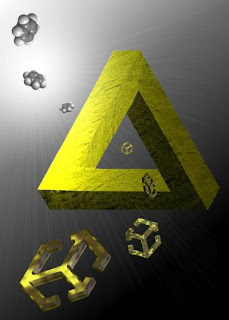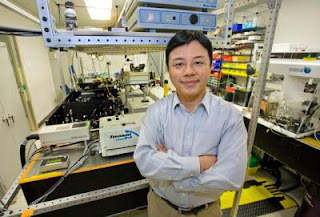Möbius symmetry, the topological phenomenon that yields a half-twisted strip with two surfaces but only one side, has been a source of fascination since its discovery in 1858 by German mathematician August Möbius. As artist M.C. Escher so vividly demonstrated in his "parade of ants," it is possible to traverse the "inside" and "outside" surfaces of a Möbius strip without crossing over an edge. For years, scientists have been searching for an example of Möbius symmetry in natural materials without any success. Now a team of scientists has discovered Möbius symmetry in metamaterials – materials engineered from artificial "atoms" and "molecules" with electromagnetic properties that arise from their structure rather than their chemical composition.
Xiang Zhang, a scientist with the U.S. Department of Energy's Lawrence Berkeley National Laboratory (Berkeley Lab) and a professor at the University of California (UC) Berkeley, led a study in which electromagnetic Möbius symmetry was successfully introduced into composite metamolecular systems made from metals and dielectrics. This discovery opens the door to finding and exploiting novel phenomena in metamaterials.
"We have experimentally observed a new topological symmetry in electromagnetic metamaterial systems that is equivalent to the structural symmetry of a Möbius strip, with the number of twists controlled by sign changes in the electromagnetic coupling between the meta-atoms," Zhang says.
While some symmetries, such as spatial geometries, are easily observed, others, such as optical symmetries, may be hidden. A powerful investigative tool for uncovering hidden symmetries is a general phenomenon known as "degeneracy." For example, the energy level degeneracy of an atom in a crystal is correlated with the crystal symmetry. A three-body system, like a trimer, can be especially effective for studying the correlation between degeneracy and symmetry because, although it is a relatively simple system, it reveals a rich spectrum of phenomena.
"The unique properties of a three-body system make experimental investigations of hidden symmetries possible," says Chih-Wei Chang, a former post-doc in Zhang's group and the lead author of the paper in Physical Review Letters, says. "Intrigued by the extraordinary engineering flexibilities of metamaterials, we decided to investigate some non-trivial symmetries hidden beneath these metamolecules by studying their degeneracy properties"
The authors tested their metamaterials for hidden symmetry by shining a light and monitoring the optical resonances. The resulting resonant frequencies revealed that degeneracy is kept even when the coupling constants between meta-atoms flip signs.
"Because degeneracy and symmetry are always correlated, there must be some symmetry hidden beneath the observed degeneracy" says Chang.
The researchers showed that whereas trimer systems with uniform negative (or positive) coupling signs could be symbolized as an equilateral triangle, trimer systems with mixed signs of couplings could only be symbolized as a Möbius strip with topological C3 symmetry. Furthermore, in other metamolecular systems made of six meta-atoms, the authors demonstrated up to three Möbius twists.
Says Chang, now a faculty member at National Taiwan University in Taipei, "When going from natural systems to artificial meta-atoms and metamolecules, we can expect to encounter phenomena far beyond our conventional conceptions. The new symmetries we find in metamaterials could be extended to other kinds of artificial systems, such as Josephson junctions, that will open new avenues for novel phenomena in quantum electronics and quantum optics." ###
This research was supported by the DOE Office of Science and by the NSF's Nano-scale Science and Engineering Center.
Lawrence Berkeley National Laboratory is a U.S. Department of Energy (DOE) national laboratory managed by the University of California for the DOE Office of Science. Berkeley Lab provides solutions to the world's most urgent scientific challenges including sustainable energy, climate change, human health, and a better understanding of matter and force in the universe. It is a world leader in improving our lives through team science, advanced computing, and innovative technology. Visit our at www.lbl.gov
Contact: Lynn Yarris lcyarris@lbl.gov 510-486-5375 DOE/Lawrence Berkeley National Laboratory
















No comments:
Post a Comment